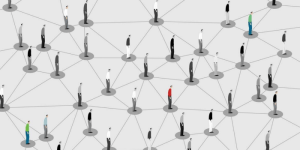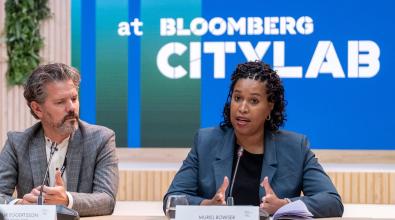Contact tracing: What cities can do to improve public cooperation

Contact tracing is a tried-and-true public-health tool that has worked for years to combat tuberculosis, HIV, measles, and other communicable diseases. Now it’s being scaled up to tackle COVID-19 and is considered one of the four capacities cities will need to “box in” the virus, in addition to widespread testing, isolating the sick, and quarantining those who have been exposed.
The work requires loads of telephone calls, in-depth case-history investigations, and the ability to persuade people who’ve been exposed to quarantine themselves at home. And, because success depends not only on the contact tracers but also on the people being contacted, there are a ton of challenges, starting with getting people to answer the phone.
For those who do answer, some are confused by what contact tracing is. Others are worried about privacy, wary of fraudsters, suspicious of government, or simply can’t remember who they’ve been in contact with. Not to mention frightened about the prospects of becoming seriously ill or being unable to go to work or shop for food for two weeks.
While not all cities run their own contact-tracing programs — many are led out of county or state government — there are steps city leaders can take to improve the public’s cooperation in this critical effort. Here are four of them.
Step up public communication and outreach. Most Americans had never heard of contact tracing a few months ago. Mayors can use their bully pulpits to educate residents about its important role in keeping people healthy and allowing the economy to remain open during the pandemic. They also can reassure residents that their personal information will remain confidential, that a contact tracer will never ask for your Social Security number, credit card information or immigration status, and that supports are available for people who need help with quarantine.
Some of that communication needs to happen at the time of testing: Residents should understand that if their COVID-19 test comes back positive, they’ll be getting a call from a contact tracer and that it’s critical they answer the phone. Some cities, such as Baltimore, have launched social media campaigns to educate residents about contact tracing. The Johns Hopkins Bloomberg School of Public Health, together with Bloomberg Philanthropies, offers a free online course to train contact tracers. Additionally, the CDC has a contact tracing communications toolkit with talking points, sample language for public service announcements and social media posts, and educational graphics.
Authority figures are not always the best messengers for sensitive guidance, so it’s important to engage trusted community partners in outreach efforts. “Develop a coalition of community organizations to regularly inform and receive guidance about contact tracing,” said Dr. Joshua Sharfstein of the Johns Hopkins Bloomberg School of Public Health. “This can help diffuse understanding of the need for participation, while providing necessary feedback about how outreach efforts can be improved.”
Build trust by phone. One simple fix is to make sure that when a contact tracer calls, the caller ID makes clear that it’s the local health department on the other end of the line, and not a telemarketer. The U.K. took this a step further. If you skip answering the call — but then call that number back — you’ll hear an automated message stating clearly that a contact tracer will be calling again, so please make yourself available to protect your friends and family.
And what about when the two sides do connect? The Behavioral Insights Team, a group that specializes in applying behavioral science to government operations, has been working with the contact tracing operation in the U.K. to make these calls as productive as possible. They’ve found that residents need reassurance that contact tracers are who they say they are — not scammers — and that any information they offer will be kept confidential.
“We want to help individual members of the public see themselves as good people in this,” said Hannah Burd, a principal advisor at B.I.T. who works on the project. “It’s fair that some people will be concerned about giving up the contact data of their friends, family, acquaintances, because they’re afraid of how they’re going to look, or because they want to protect those people. But obviously, the best thing you can do in this pandemic is get the message to people who might be at risk of the virus. It’s important to restate that message several times on the calls.”
Another challenge, Burd said, is getting individuals to remember everybody they’ve been in close contact with. Contact tracers in the U.K. are now using tricks to jog memories, such as asking people to flip through their calendars and think about what they did each day, or look through their text messages for clues. “Just asking people to recall cold who they’ve been in contact with over the last two weeks, the common reaction is, ‘I can’t even remember what I had for breakfast,’” Burd said. “Getting that out of people requires different nudges.”
Take hiring and training seriously. Contact tracing is a delicate art requiring as much empathy as perseverance. As cities, counties, and states staff up and hire 100,000 or more people to do the job, they’re finding they need people with the right temperament and need to invest in training.
That’s something Paterson, N.J., did last year — before anyone had even heard of COVID-19. The city’s health division cross-trained health educators, nurses, lead inspectors, and others to be able to do contact tracing; when the coronavirus hit, they were able to scale up quickly from two staff who did this sort of work before the pandemic to 55. Dr. Paul Persaud, the division director, said this foundation of public-health professionalism is what helped the city successfully reach 91 percent of the people his contact tracers reached out to.
“Contact tracing is not as simple as it’s made out to be,” Persaud said. “You need to develop a rapport with people. They want to know who you are and what you do. And if you work in public health, that makes it much easier to gather information. The team needs to be well-trained and has to be professional and understand what they are actually doing. They’re not just making phone calls for the sake of making phone calls but have a vested interest in this.”
It’s also important that contact tracers reflect the diversity of the city they’re working in. That’s a key component of a new contact-tracing program in Baltimore that will be hiring 300 people. In Paterson, Persaud said, Hispanic and Bangladeshi members of his team are critical to reaching out to members of those communities. One member of his contact-tracing team is a police officer, who goes out to knock on the doors of anyone who doesn’t answer the phone.
“It’s very difficult to send our people out to make contacts, but the police are already out there working,” Persaud said. “It’s a form of community policing. We’re not out to arrest anyone because they’re infected — it’s just, ‘Hey, please return a phone call — this person in the Health Department is trying to reach you.’”
Keep in touch. Receiving a call from a contact tracer should be the beginning — not the end — of a process. Those who have COVID-19 need to isolate from others to avoid spreading the virus. Their contacts need to stay in quarantine for 14 days so that they don’t inadvertently spread the virus before potentially falling ill. For most, that means not leaving home to go to work, to go to the grocery store, to take care of a relative. Cities with support services to offer, such as hotels to isolate safely away from family or free food deliveries for those who test positive, need to connect people right away. The more that people in the community know about these services, the more likely they may be to cooperate when contact tracers call.
There are other ways of staying in touch with residents to support them through isolation or quarantine and encourage them to stay home. In Paterson, people in quarantine get daily phone calls from Persaud’s office checking in on how they’re doing. In the U.K., the Behavioral Insights Team is looking to test whether daily text messages — counting down the 14 days, and offering tips for staying home— might help people.
“If you’ve been called and told, ‘OK, you need to stay home for the next two weeks,’ you might need money. You might have care responsibilities, or need food and supplies and not have them at home,” Burd said. “What we’re looking at is, ‘Is there more we can give those people that can mean a great number of them stay at home?’”
